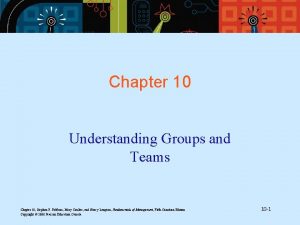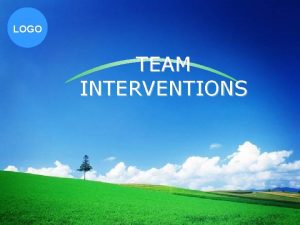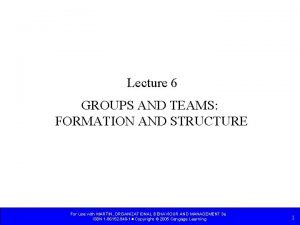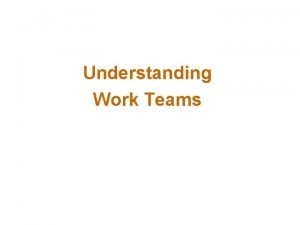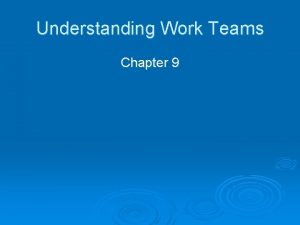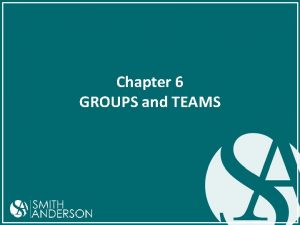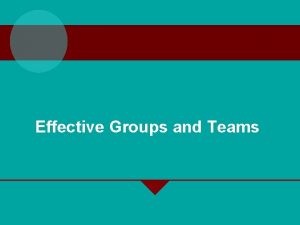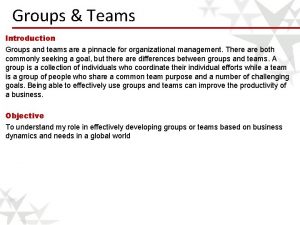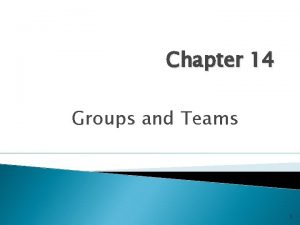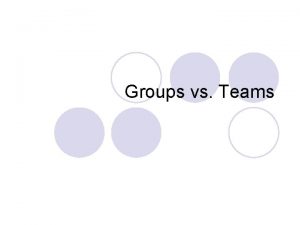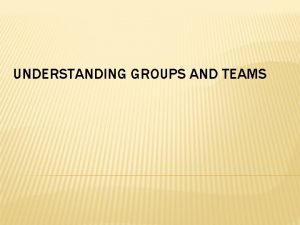Chapter 14 Understanding Groups and Teams Chapter 14








- Slides: 8

Chapter 14 Understanding Groups and Teams Chapter 14, Stephen P. Robbins, Mary Coulter, and Nancy Langton, Management, Ninth Canadian Edition Copyright © 2009 Pearson Education Canada 1

Learning Outline After you read this chapter you should know the following learning objectives: . • • #1: #2: #3: #4: What are the stages of team development? How do individuals become team players? How can groups become effective teams? What are some of the current challenges in managing teams? Chapter 14, Stephen P. Robbins, Mary Coulter, and Nancy Langton, Management, Ninth Canadian Edition Copyright © 2009 Pearson Education Canada 2

Understanding Groups • Group – Two or more interacting and interdependent individuals who come together to achieve particular goals • Formal groups – Work groups that have designated work assignments and tasks directed toward organizational goals • Informal groups – Groups that are independently formed to meet the social needs of their members Chapter 14, Stephen P. Robbins, Mary Coulter, and Nancy Langton, Management, Ninth Canadian Edition Copyright © 2009 Pearson Education Canada 3

Examples of Formal Groups • • Command Task Cross-functional Self-managed Exhibit 14. 1 Chapter 14, Stephen P. Robbins, Mary Coulter, and Nancy Langton, Management, Ninth Canadian Edition Copyright © 2009 Pearson Education Canada 4

Difference Between Groups and Teams • Groups • Teams – Interact primarily to share information and to make decisions to help each member do his or her job more efficiently and effectively Chapter 14, Stephen P. Robbins, Mary Coulter, and Nancy Langton, Management, Ninth Canadian Edition Copyright © 2009 Pearson Education Canada – Work intensely on a specific, common goal using their positive synergy, individual and mutual accountability, and complementary skills 5

What Is a Team? • Work Team – A group whose members work intensely on a specific common goal using their positive synergy, individual and mutual accountability, and complementary skills • Types of Teams – Problem-solving teams – Self-managed work teams – Cross-functional teams – Virtual teams Chapter 14, Stephen P. Robbins, Mary Coulter, and Nancy Langton, Management, Ninth Canadian Edition Copyright © 2009 Pearson Education Canada 6

Stages in Team Development • Forming – Members join and begin the process of defining the group’s purpose, structure, and leadership • Storming – Intragroup conflict occurs as individuals resist control by the group and disagree over leadership • Performing – A fully functional group structure allows the group to focus on performing the task at hand • Adjourning • Norming – The group prepares to disband is no longer concerned with high levels of performance – Close relationships develop as the group becomes cohesive and establishes its norms for acceptable behaviour Chapter 14, Stephen P. Robbins, Mary Coulter, and Nancy Langton, Management, Ninth Canadian Edition Copyright © 2009 Pearson Education Canada 7

Ex. 14. 3 Stages of Team Development Chapter 14, Stephen P. Robbins, Mary Coulter, and Nancy Langton, Management, Ninth Canadian Edition Copyright © 2009 Pearson Education Canada 8


